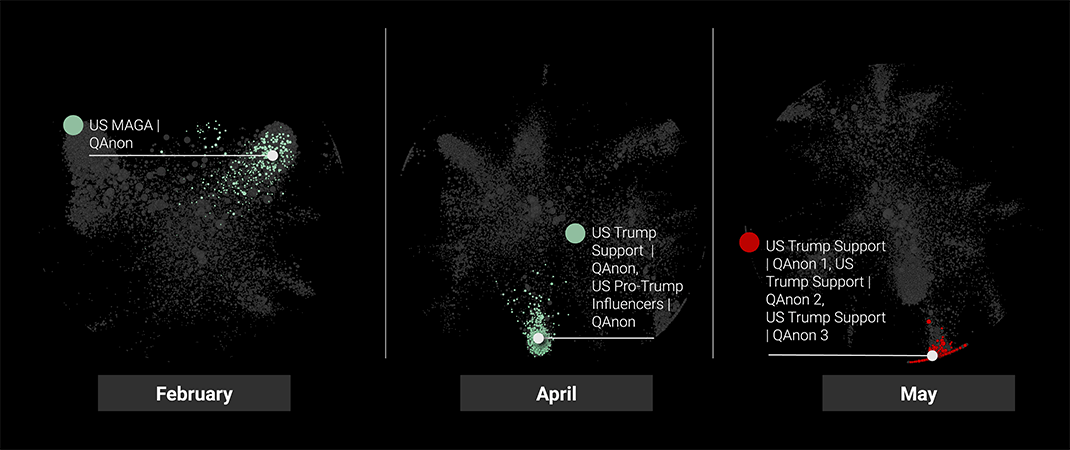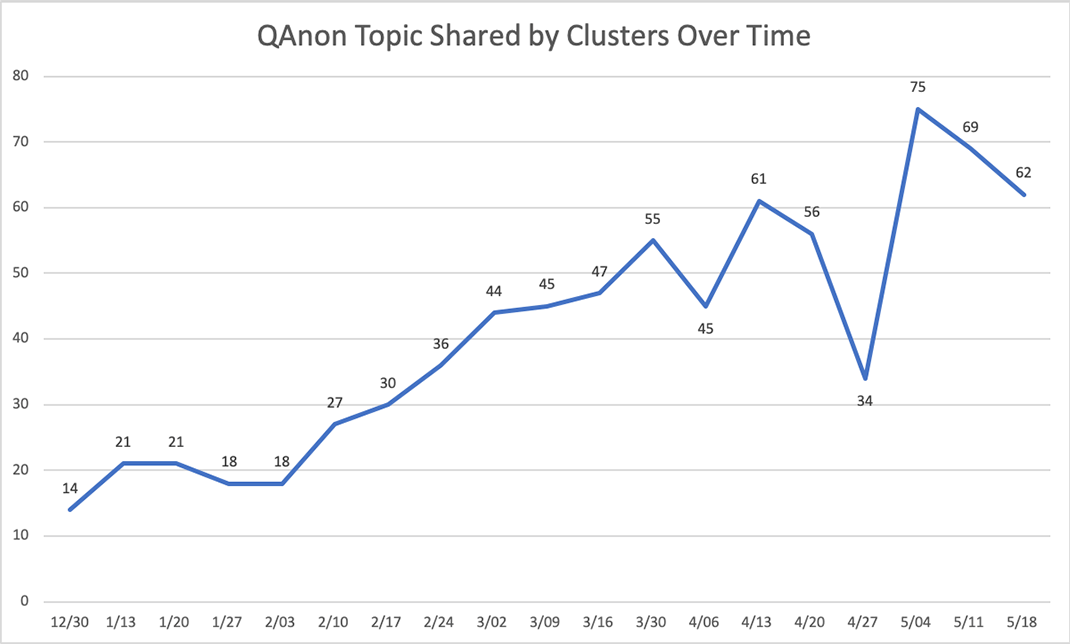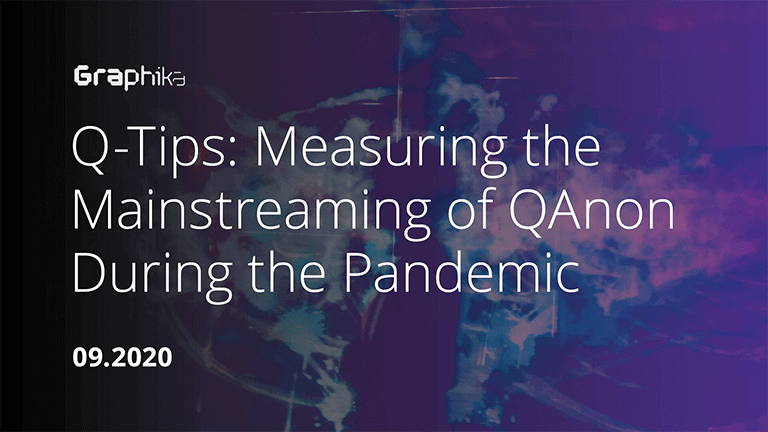Journalists and researchers alike have observed the undeniable growth of conspiratorial content during the COVID-19 pandemic. Their important work shows the increased volume and frequency of sharing QAnon content across social media platforms over the last seven months. While hashtag and keyword counts can indicate a change in the amount of conspiratorial content being shared over time, this approach does not capture how content becomes a shared ideology across established online communities. To help complete the picture, the Graphika team developed a new set of methods leveraging network analysis, topic modeling, and cultural bridging to identify content, users, topics and hashtags that connect otherwise disconnected communities. The output of this multi-modal approach reveals the content and topics that accelerated relationships between accounts engaging with the QAnon community and adopting their messages. Our results quantify what we have seen since the early weeks of the pandemic: the QAnon worldview has acted as a catalyst for the convergence of online networked conspiracy communities, anti-vaxx and anti-tech alike.
To conduct this analysis, Graphika researchers developed a multimodal approach which is covered in detail in a recent paper. The models were built from five months of COVID-19 conversation data (January through May 2020) that was collected as a result of Graphika’s ongoing efforts to track the evolving COVID-19 conversation using a time-bounded series of network maps. Among the general COVID-19 discourse, these maps captured conspiratorial threads closely tied to QAnon’s worldview, for example the “plandemic”, which asserts that COVID-19 was created by Bill Gates and other elites for population control.
QAnon and COVID-19: The Network
Analysis of our COVID-19 networks and clustering showed that when the QAnon group emerged it was closely tied to the US right-wing groups. Over time, this group became less composed of other right-leaning clusters, like followers of Fox News hosts and accounts that consistently support Trump, and staunch QAnon support accounts took their place. In our COVID-19 maps, the core QAnon community and the Trump support group were both deeply interconnected on a network level and mutually amplifying each other’s content and narratives. This aligns with findings from Graphika’s monitoring of the online QAnon community since 2018. When we first mapped the network of QAnon supporters in June 2018, it was the most dense conspiratorial network Graphika had ever studied. Accounts engaged in QAnon theories at the time had an astounding rate of mutual followership and represented an extremely tight-knit online community. Another Graphika report published recently details key observations about the evolution of this community and outlines three principal concerns ahead of the US presidential elections.
This does not suggest the right-wing accounts “became” QAnon supporters necessarily, but it does indicate the QAnon community became increasingly more vocal and salient in the COVID-19 conversation over time. Prior to the pandemic, the QAnon community was concentrated on the periphery of the network and often connected into the mainstream through right-wing groups (see the map series below). The QAnon community was less than 3% of the conversation around COVID-19 in February 2020. By April 2020, despite a substantial decrease in participation from all other right-wing groups, this community comprised almost 5% of the network, and was composed of increasingly dense clusters.
Here, group density is measured by homophily, which uses Twitter followership patterns within a group to calculate how insular a group is compared to the larger network. In February the QAnon group had a homophily score of .09 whereas in May scores for QAnon clusters ranged from 5.57-20.77. Taken together, this says that overtime, QAnon accounts in the COVID-19 map became both bigger and a tighter-knit community. By contrast, other US right-wing groups constituted 6.2% of the total March map and steadily decreased in presence until June. The February, April, and May maps below show this progression, and by June the Trump support group was absent from the COVID-19 map. In its place was a group of accounts that exhibited distinct and more focused conspiratorial and QAnon engagement, such as following QAnon influencers and sharing QAnon hashtags like #WWG1WGA.
 The QAnon clusters in Graphika’s February, April, and May COVID-19 maps.
The QAnon clusters in Graphika’s February, April, and May COVID-19 maps.
The Spreading QAnon “Topic”
The next phase of our research approach modelled topics across all clusters in the five COVID-19 maps, including the growing clusters of QAnon accounts participating in the COVID-19 conversation that surfaced during the network building. Topic modeling is a method used for finding groups of words from a collection of text, a corpus, that best represent the information in the corpus, tweet text in this case. This method allowed for the discovery of hidden, recurring patterns in Tweet text data from our COVID-19 map series. This process identified distinct topics of conversation that were prevalent across the COVID-19 conversation network, ranging from politics to culture, and importantly including four QAnon topics. These topics included QAnon words and hashtags like ‘q’, ‘#stormisuponus,’ ‘qanon,’ and ‘flynn,’ but also commonly engaged with influential accounts in the QAnon community including QAnon leading voices @inevitable_et (now suspended), @prayingmedic, along with leading political figures such as @realdonaldtrump.
Over the five months of monitoring, the QAnon topic became increasingly used in a range of geographically and ideologically diverse communities (see graph below). In the first week of January, 15 distinct clusters from our collection of networks partaking in the COVID-19 conversation were engaging with the QAnon topic. By May 5th, 75 were. In December and January this topic was engaged with predominantly by US Trump support groups, with the exception of a UK pro-Brexit cluster and the K-pop community (which, prior to targeting white supremacist campaigns, would use arbitrary hashtags to boost engagement, which could have included QAnon-adjacent hashtags). The QAnon topic engagement stayed level for the month of January, but by mid-February the clusters engaging in the topic were diversifying. The groups were still right-leaning but were geographically diverse, including clusters of accounts from France, Brazil, and other international conspiratorial groups that preferentially follow influencers on the political right such as Paul Joseph Watson, Charlie Kirk, and Jordan Peterson.
 The number of individual clusters partaking in the QAnon topic grew significantly from the beginning of the year until May.
The number of individual clusters partaking in the QAnon topic grew significantly from the beginning of the year until May.
Late February through early April were marked by a strong, steady increase in clusters engaging with the QAnon topic with a consistent core of US Trump support clusters and a diversity of new geographic and ideological alignments. Often, the introduction of a new cluster engaging with the QAnon topic aligned with a spike in COVID-19 infection rates in the respective country. For example, during this time a conservative Italian cluster began to consistently participate in the QAnon conversation; since April a steady increase in Latin American engagement is notable. By May, several international conspiratorial clusters – followers of Indian conservative influencers, followers of mainstream figures like soccer players and celebrities – and continued engagement from far-right groups around the globe were participating in this topic. In total there were 17 different nations across 74 clusters using language from the QAnon topic in their tweets.
This also was the first instance of a left-leaning US cluster, an online “Resist” group, systematically engaging with QAnon language and could indicate these accounts discussing or critiquing the conspiracy theory with growing momentum. It is important to reiterate that the Resist group and others mentioned were not solely focusing on the QAnon topic. It was one topic among many that the group engaged with during this time period. In the final week in our data collection period, beginning May 18, new instances of mainstream US media and US progressive media systematically engaged with distinct markers characteristic of our modelled QAnon topics (phrases, accounts, hashtags, etc.), which indicates substantial progress towards becoming a mainstream topic of conversation.
For comparison, the line graph below shows the progression of other US topics over the course of the five months of data. Some topics, like US-Iran relations (in blue), were discussed at high volume at the beginning of the year, likely spurred by the assassination of Qasem Soleimani, but this decreases in February. The US Politics topic (in green) oscillates in engagement, the spikes and wanes likely due to a volatile news cycle around the 2020 elections. The QAnon line in purple, on the other hand, increases over time, with a few intermittent drops, and surges at the end of April and beginning of May. Notably, the beginning of May is when the widely-shared, conspiratorial documentary ‘Plandemic’ was released online.
 US-specific topics over time across the COVID-19 maps. P is the probability that text from an account over a week will be classified as a topic.
US-specific topics over time across the COVID-19 maps. P is the probability that text from an account over a week will be classified as a topic.
QAnon as a Cultural Bridge
Accounts classified within the QAnon community were clearly increasingly salient in the COVID-19 online conversation over time, and the QAnon topics became increasingly pervasive across groups in the COVID-19 maps. Cultural bridging is a method of identifying content, users, topics and hashtags that connect otherwise disconnected communities. For example, an environmental justice group may not communicate often with members of an organic food movement until a topic arises that is of interest to both groups (e.g., negative consequences of pesticide and fertilizer overuse). After such a topic arises, members from the two groups may become more socially similar, synthesizing new ideas from their own respective ideologies and interests. In the proceeding cultural bridging analysis, the QAnon topics discussed above were identified as significant bridges between communities across the maps. That is to say that the QAnon topic acted as an important topic that drew together otherwise disparate communities. The top bridging topics are coronavirus and the country participating in that conversation (i.e. COVID-19 in Italy), suggesting that these topics connect residents of that country across the maps’ political and cultural cluster boundaries. The only topic in the top ten bridges that was not a COVID-19 or country-based topic was QAnon.
The results also indicate the topics, hashtags, URLs, and accounts that connected existing QAnon accounts to other communities. The bridges that most connected QAnon to existing communities indicate that Christianity and spirituality were important bridges that connected QAnon to other communities – overall the hashtag that bridged QAnon clusters to other communities most significantly was #Catholic. While top bridging hashtags earlier in the pandemic were more COVID-19 focused, such as #BillGatesVirus (top bridge the week of 4/6) and #coronaviruswars (top bridge the week of 3/30), religion and spirituality hashtags were more consistent bridges over time. This suggests that the pandemic may have contributed to accelerated spread of QAnon narratives, but religion and spirituality content, not COVID-19 content, was the consistent bridge that connected QAnon groups to other communities during this time period. It also supports the New Age to QAnon pipeline observed by other researchers in which health and wellness influencers are introducing their followers to QAnon content. Other hashtags with high bridging scores, and those that were consistently high each week, were #astrology, #gemini, and #spiritual.
One of the QAnon topics, “Christian QAnon”, was also consistently a top topical bridge between QAnon and other groups. This topic included words like “god,” “stormisuponus,” and the QAnon Christian influencer “prayingmedic.” Coronavirus and politics were also top topic bridges for several weeks. This trend tracks with the top user account bridges that connected QAnon communities to others. The interests of the accounts range from conservative politics to Bitcoin to Christianity. Surprisingly, the bridge accounts have smaller follower networks (each around ~5,000 followers with a few exceptions) and none were notably influential in the online QAnon space. Despite QAnon influencers being core to the QAnon community, our analysis suggests it is smaller accounts that first introduce QAnon content and concepts to outside groups.
Lasting Effects
This is a preliminary analysis of the rise of QAnon amidst the pandemic and the accounts, content, and topics that bridged and have sustained this worldview across online communities. This analysis uses a small subset of results yielded from our pipeline of network analysis, topic modeling, and cultural bridging. Continued analysis will surface where online, at what date and how QAnon and other conspiratorial worldviews spread throughout the pandemic and the content that aided in that process. The results support the hypothesis that over the course of the pandemic, the QAnon community has not only grown more influential in COVID-19 discourse, but that QAnon content and concepts have taken hold in other communities.
The QAnon community started as a fringe conspiracy-focused group that has notably gained momentum both in our COVID-19 online networks and in political life. The first QAnon-supporting congressional candidate won the Georgia Republican House primary and is favored to win the seat in the fall. QAnon has been linked to a growing list of crimes carried out by individuals in the past six months, and was labelled a domestic terror threat by the FBI - demonstrating the potential for this community to cause real-world harm. The recent Twitter and Facebook takedowns of thousands of QAnon accounts and groups attest to growing concerns about QAnon’s spread and influence. Despite these efforts, our research indicates the QAnon ideology took hold months ago in many communities and a resilient infrastructure supporting QAnon ideology has been established on social media platforms.
